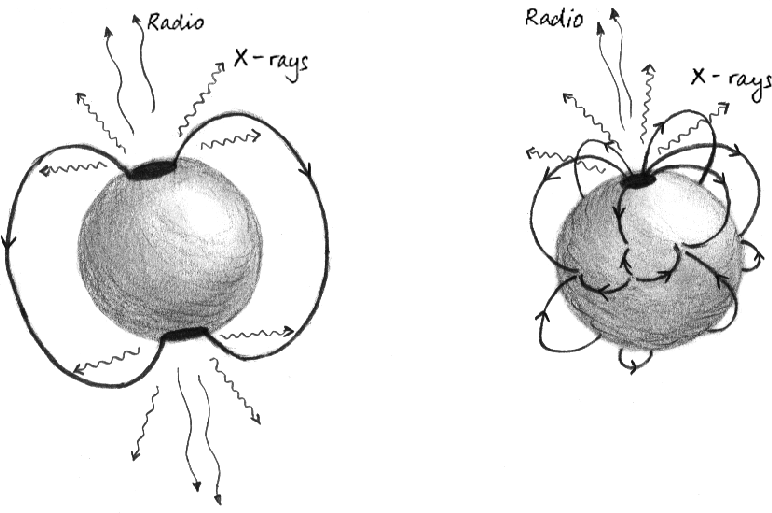Complex magnetic fields on PSR J0437-4715




Next: Gamma-ray pulsars with
Up: Research highlights
Previous: Close encounters
Mark Walker has argued that the surface magnetic fields
on the millisecond pulsar PSR J0437-4715 are very different to the
simple `bar magnet' geometry which is usually assumed.
Australian astronomers have discovered about half of the
600 known radio pulsars.
Of these known pulsars, PSR J0437-4715 is especially
interesting because it is only 400 light-years away and is
therefore very bright. This source has been observed in other
wavebands - optical, X-ray and  -ray.
Its properties in the X-ray band are particularly interesting:
exceptionally strong pulses are seen over a narrow range of energies.
Mark Walker has identified this as a signature of a particular
type of X-radiation, namely cyclotron radiation, which is produced
by electrons executing circular orbits in a strong magnetic field.
If this identification is correct, it represents the first
observation of a cyclotron line in any radio pulsar.
If the X-ray pulses are cyclotron emission one can easily measure
the strength of the pulsar's magnetic field,
from the energy of the X-rays observed,
and it is found to be eight million Tesla (i.e. about a million
times larger than the strongest steady man-made fields).
-ray.
Its properties in the X-ray band are particularly interesting:
exceptionally strong pulses are seen over a narrow range of energies.
Mark Walker has identified this as a signature of a particular
type of X-radiation, namely cyclotron radiation, which is produced
by electrons executing circular orbits in a strong magnetic field.
If this identification is correct, it represents the first
observation of a cyclotron line in any radio pulsar.
If the X-ray pulses are cyclotron emission one can easily measure
the strength of the pulsar's magnetic field,
from the energy of the X-rays observed,
and it is found to be eight million Tesla (i.e. about a million
times larger than the strongest steady man-made fields).
Such large fields are not unusual in pulsars, but it had been thought
that the magnetic field of PSR J0437-4715 was only one hundredth of
this value - this inference had been drawn from the observed rate
at which the spin of the pulsar is slowing down.
In order that the rate of spin-down be consistent with a
high magnetic field it is necessary to abandon the commonly held idea
that the pulsar's field structure is a simple dipole
- i.e. like that of a bar magnet.
The field must, instead, be quite complicated
and may look something like the field structure shown in Figure 5.

Figure: A sketch of the standard picture of the field structure of a pulsar (left) and a more complicated structure such as that suggested by Mark Walker's modeling of PSR J0437-4715.
Because pulsars are so compact - i.e. they contain a lot of mass in a small
volume - their gravitational fields are extremely strong; so strong,
in fact, that light passing near them moves on profoundly curved paths.
A distant observer can therefore see a good fraction of the back side
of a pulsar, as well as all of the near side.
These light-bending effects need to be calculated quite carefully
in order to understand the shape of the X-ray pulses from the pulsar.
This sort of detailed modeling of PSR J0437-4715 indicates
that almost all of the X-ray emission is coming from a single
hot-spot on the surface of the pulsar,
in contrast to the two luminous hot-spots which are expected
for a dipole magnetic field.
Mark's work may lead to a major revision of many firmly-held beliefs regarding
the structure of magnetic fields around pulsars.




Next: Gamma-ray pulsars with
Up: Research highlights
Previous: Close encounters
Stephen Hardy / stephen@physics.usyd.edu.au
 -ray.
Its properties in the X-ray band are particularly interesting:
exceptionally strong pulses are seen over a narrow range of energies.
Mark Walker has identified this as a signature of a particular
type of X-radiation, namely cyclotron radiation, which is produced
by electrons executing circular orbits in a strong magnetic field.
If this identification is correct, it represents the first
observation of a cyclotron line in any radio pulsar.
If the X-ray pulses are cyclotron emission one can easily measure
the strength of the pulsar's magnetic field,
from the energy of the X-rays observed,
and it is found to be eight million Tesla (i.e. about a million
times larger than the strongest steady man-made fields).
-ray.
Its properties in the X-ray band are particularly interesting:
exceptionally strong pulses are seen over a narrow range of energies.
Mark Walker has identified this as a signature of a particular
type of X-radiation, namely cyclotron radiation, which is produced
by electrons executing circular orbits in a strong magnetic field.
If this identification is correct, it represents the first
observation of a cyclotron line in any radio pulsar.
If the X-ray pulses are cyclotron emission one can easily measure
the strength of the pulsar's magnetic field,
from the energy of the X-rays observed,
and it is found to be eight million Tesla (i.e. about a million
times larger than the strongest steady man-made fields).
